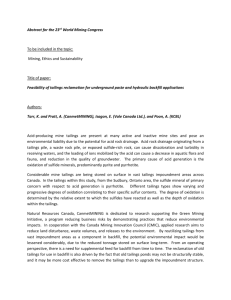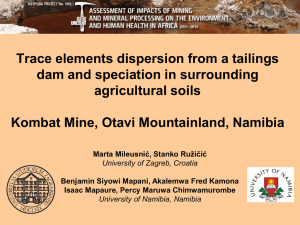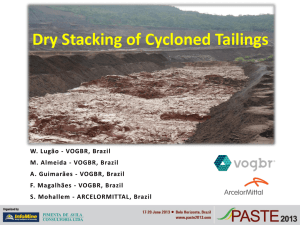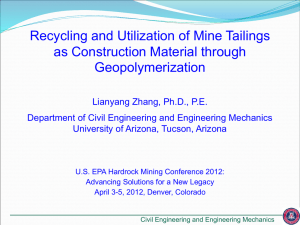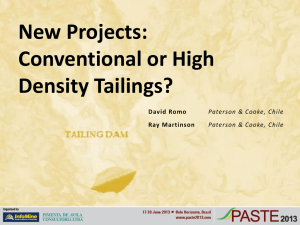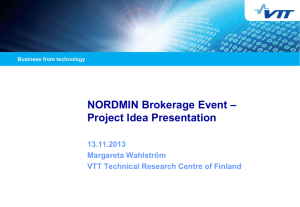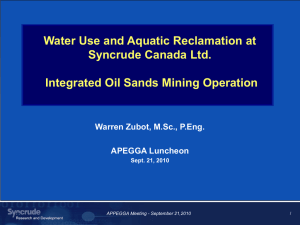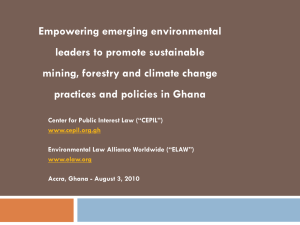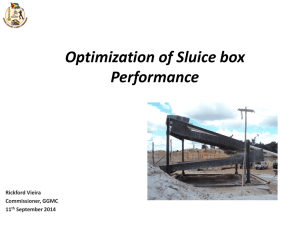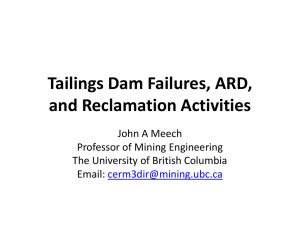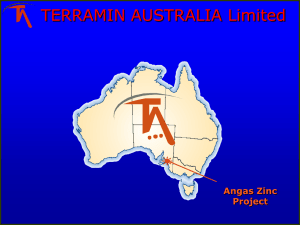Tailings Roadmap and Action Plan
advertisement
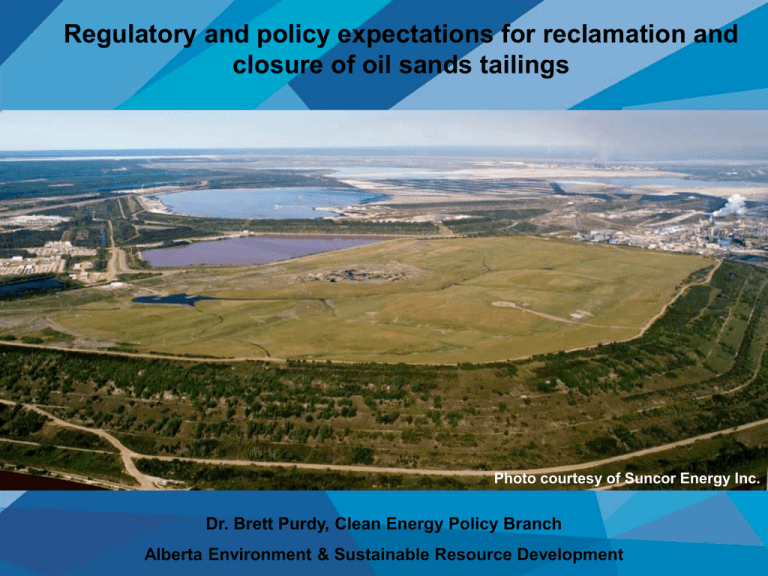
Regulatory and policy expectations for reclamation and closure of oil sands tailings Photo courtesy of Suncor Energy Inc. Dr. Brett Purdy, Clean Energy Policy Branch Alberta Environment & Sustainable Resource Development Tailings reclamation objectives are not unique … … reclaim so that soils and landforms are capable of supporting • a self-sustaining, locally common boreal forest • integrated / sustainable surface drainage • natural appearances Tailings have already been reclaimed … … more tailings have been reclaimed than any other part of the mine footprint to date … … the Roadmaps identify pathways to make the “challenging” tailings ready for reclamation … While innovation and commercialization pathways are identified in the roadmaps … we need to ask the question … ... do “ready for reclamation” tailings technologies / criteria support “reclamation and closure” objectives” ? Unique challenges for reclamation of tailings … Surface water & groundwater interactions Landform cap & soil placement Ecosystem development Landform design CTMC Tailings Roadmap Overview Tailings Technology Project Roadmap Update OSTC/COSIA AI-EES / CTMC GE Innovation Centre August 28, 2012, Calgary Presentation outline Project scope Project process Project results Project scope In 2011, Alberta Innovates – Energy and Environment Solutions & the Oil Sands Tailings Consortium awarded a contract to the Consortium of Tailings Management Consultants (CTMC) to produce “The Technology Deployment Roadmap and Action Plan for ‘End-to-End’ Solutions for Oil Sands Tailings.” The CTMC summarized and assessed 549 technologies and produced a set of roadmaps for the most promising of these technologies & suites. This presentation is a summary of the CTMC June 2012 final report. Project objective To create a technology deployment roadmap and action plan that will assist regulators and industry to create and implement technology solutions that will meet specific tailings management and reclamation goals Component 1 Compile state of practice, describe existing technology suites, & compile full list of technologies Component 2 Develop assessment criteria Component 3 Evaluate opportunities, technologies, identify data gaps Component 4 Highlight & prioritize technologies through a development roadmap Methods: Component 1 Seek out the widest range of potential tailings technologies Summarize technologies Define technology categories Exploration Mining Extraction Tailings processing Water treatment Certification Reclamation Tailings deposition and capping Assign stage of development Research Commercial Development Pilot Prototype Create master list of technologies 549 Technologies 101 Unique Technologies +15 Chemical Amendments +18 water treatment technologies Detailed log of fate of every technology and all vendor communications State of practice: Commercial tailings practice review Individual tailings technologies are combined to form feasible commercial technology suites specific to each mine Current state of practice and existing technology suites well documented in report Captured the major constraints and influences on tailings management – every site at every point in time is unique Methods: Component 2 Identify End Goals • Desired tailings management and reclamation end goals • Related constraints and assumptions Identify Assessment Criteria • Stage of technology • Technical feasibility • Reliability • Ability to scale up • Reclamation potential • Other practical indicators Methods: Component 3 Define assessment guidelines for each of the seven tailings categories Develop tool to assist in data analysis of technologies Assemble multi-disciplinary teams of experts to evaluate technologies Evaluate technologies against C2 criteria, recording comments and ideas for improvement too Methods: Component 4 Highlight technologies that would improve existing technology suites Highlight promising new technologies Prioritize highlighted technologies Develop roadmap Establish big picture context for roadmap PROJECT RESULTS An information packed report Technology framework and database State of practice captured Highlighted / prioritized technologies Roadmaps Conclusions Recommendations 7 + 5 Suites identified Pre-commercial and commercial suites Conventional tailings Composite tailings Thickening In-line thickening with thin lift evaporative drying In-line thickening with accelerated dewatering Water capped end pit lake “New” Technology Suites In-pit tailings treatment and deposition Non-water based extraction methods Low-cost Centrifuging MFT with conveyor / Improvement to water-based extraction stacking Separate high-fines ore and low-fines ore streams Priority assessment Comparison of benefit/risk ratio to cost – to set priority for technology development (Lower capital and operating costs result in a high cost rating) High priority technologies Extraction Deposition and capping T-024 / T-548 Alberta Taciuk Process / Retort Based Extraction T-032: Accelerated Dewatering T-062: Co-mixing MFT & Overburden* T-090: Vertical Drains Tailings processing T-099: Stacker Hydro-cyclones T-060: MFT Spiked Whole Tailings* T-188: Under-Drained Tailings* T-069: Solid Bowl Scroll Decanter Centrifuge T-510: Tailings Discharge Tremmie T-085: Thermal Drying* T-197: Super CT Reclamation T-208: Paste thickener T-138: Water Capped MFT Lake T-267: Froth Treatment Tailings Thickening* T-550: Tailings Surface Sealants** T-529: Oleophillic Sieve * restricted application ** very limited use Tailings Technology Deployment Roadmaps A description of the technology suite Improvement opportunities and gap-filler technologies Technology deployment table for each technology Conclusions There is no silver bullet… Instead, highlighted is the need for … different suites of technologies for different operators with different conditions with different legacies at different times Every site is unique There are significant opportunities to refine existing technology suites, including through more focussed management activities New technologies take time to develop: Research (2 to 3 years) Development (2 to 5 years) Commercial implementation (5 to 10 years) Nine tailings technology deployment roadmaps were developed…. Improvement opportunities for new and existing technologies Applicable technologies identified Development status mapped to identify future steps for R&D CTMC recommendations Operations / management Review water management practices and opportunities Remove roadblocks between companies Examine regional opportunities for waste treatment, including solids, fines, water and byproducts Technology assessment Implement a formal assessment framework for new technologies Standardize testing methods Evaluate the range of chemical amendments Research Develop enhanced monitoring techniques for slurries in pipelines and deposits Development Evaluate methods to reduce the mass of fines delivered to extraction by mining operations Evaluate the potential for creating separate extraction processes for high fines and low fines ore streams Revisit retort-based and solvent-based extraction methods Revisit the processing of froth tailings to reduce its potential environmental impacts Roadmaps Assess roadmaps for individual operations, and generate detailed R&D plans where required Expand to include mining, extraction and reclamation technologies Plan and budget to keep the roadmaps and technology database current Moving on Having delivered our report, the CTMC’s mandate is complete and the consortium has disbanded. The OSTC/COSIA and AI-EES now how the task to evaluate the results, and develop plans. CTMC member companies and individuals are available to support this next phase of development. The document provides both a snapshot in time of the oil sands industry, through the lens of tailings management. It is a valuable resource not just to the industry, its regulators and stakeholders, but to also has application to the mining industry worldwide. Expert participants CTMC Leads Secondments Aaron Sellick, Richard Dawson (Norwest ) Al Hyndman, Bill Shaw (Total) Bill Chin, Brett Stephens (Klohn) Blair Penner, Sean Wells (Suncor) Gord McKenna, Phillip LeSueur (BGC) Darcy Cowan, Irwin Wislesky, Les Sawatsky, Sue Longo (Golder) Dave Sego (University of Alberta Geotechnical Group) Mickey Davachi (AMEC) Jeremy Boswell, John Sobkowicz (Thurber) Rick Sisson (CNRL) Ted Lord (ERCB) Plus very importantly… Expert discipline participants in the C3 sessions Junior engineers, drafters, and admin staff at each of the organizations Illustrations by Derrill Shuttleworth Tailings Roadmap Study Followup Plan August 28th News Release Event Alan Fair 39 + Formation of the Oil Sands Tailings Consortium –OSTC - December 2010 Oil Sands Tailings Consortium Develop and deploy Tailings solutions faster 40 + Tailings Roadmap Study The Study identified 549 technologies with potential use for oil sands. Included 89 vendor technologies Reduced to 101 unique technologies (plus technology variations and enhancements) TRS Vol. 2, Table 2.1 41 + Follow-up Action Plan for 48 Highlighted Technologies 16 Technologies are included in current or planned OSTC/COSIA projects 14 Technologies will be considered by Technical Working Groups 8 Technologies will be considered by OSTC/Member companies 8 Technologies are out of the current scope of the OSTC/COSIA Tailings EPA 2 Bitumen Recovery Technologies will be evaluated through a joint industry AI-EES initiative 42 + Final Comments Industry is committed to: Sharing the information necessary to progress the development of oil sand tailings technologies Working with government and Third Party Technology Developers to develop and implement tailings technologies that will ensure that oil sand tailings are successfully reclaimed on a timely basis. The Tailings Roadmap Study report can be accessed at: www.cosia.ca and www.ai-ees.ca 43 + Questions? 44
